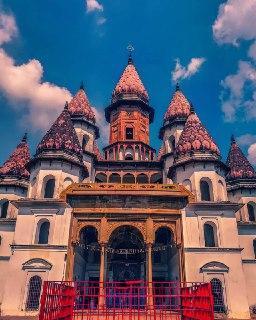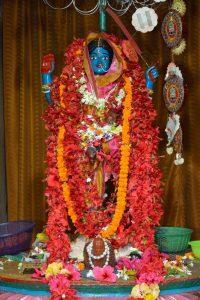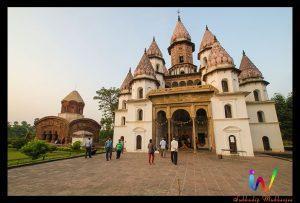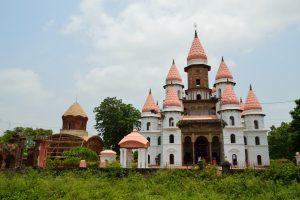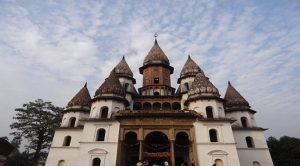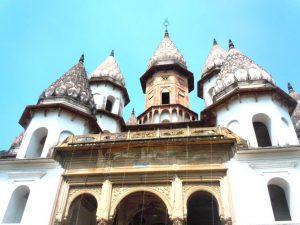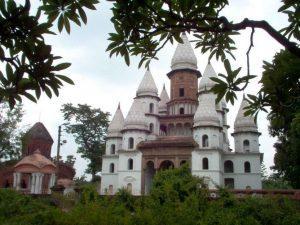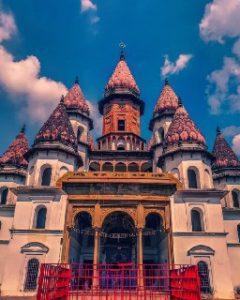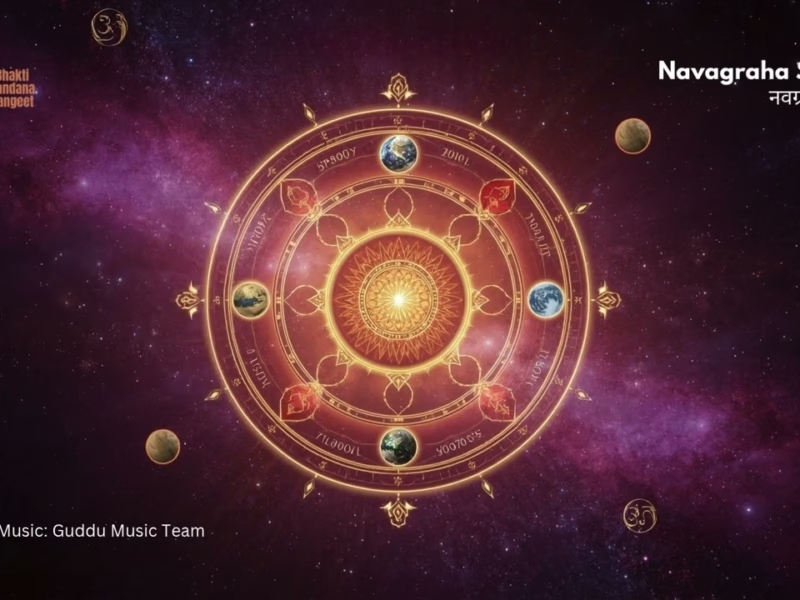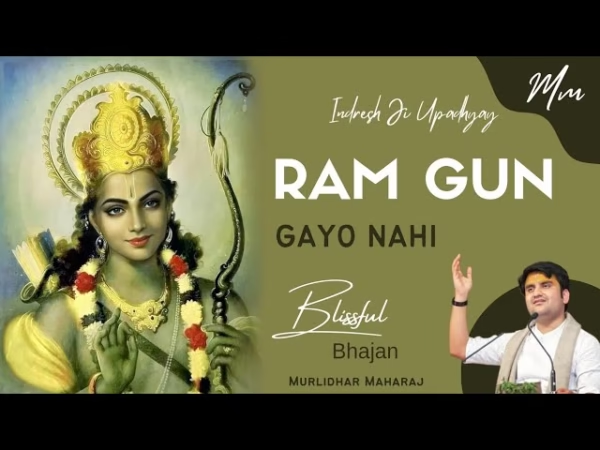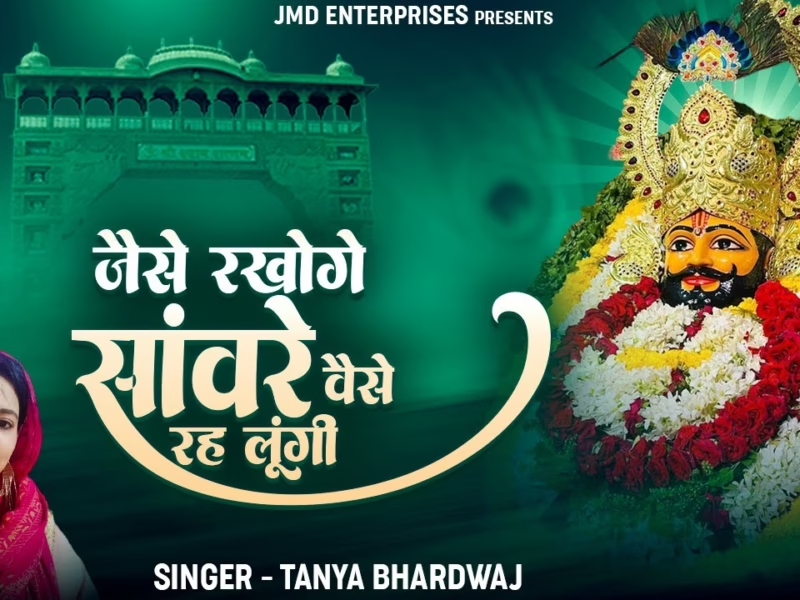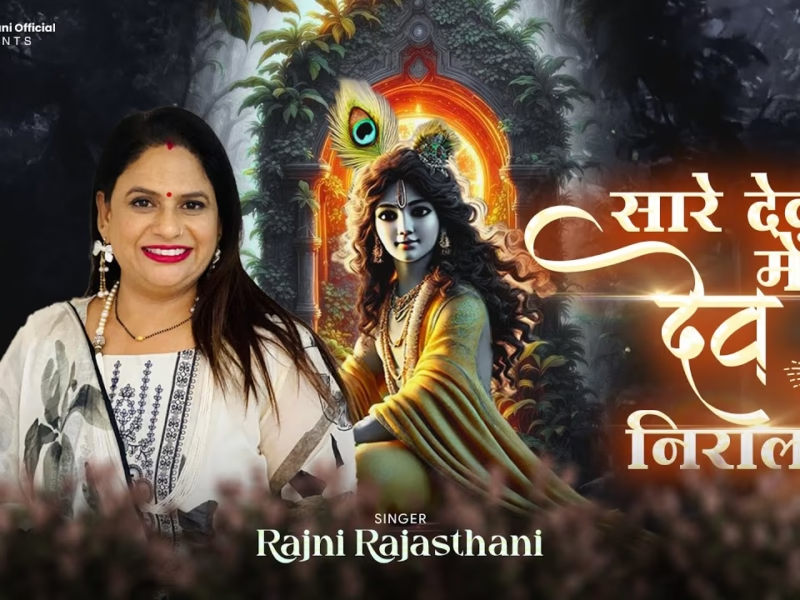Hangseshwari Temple, Hooghly, West Bengal
| Date built: | – |
|---|---|
| Deity: | Maa Hanseswari |
| Architectural style: | – |
| Major festivals | – |
| Locale: | – |
| District:: | Hooghly |
| Address: | – |
| Phone | – |
Hangseswari temple or Hanseswari temple is a Hindu Temple of goddess Hangseswari (the goddess who came in a dream of Raja Nrisingha Deb Roy Mahasay) in the town of Banshberia at Hooghly District, Indian state of West Bengal. Banshberia is an industrial town positioned in between Bandel and Tribeni. Rani Hanseswari was the mother of Raja Nrisingha Deb Roy, hence the deity is worshipped as Maa Hanseswari. The deity is worshipped as a form of Maa Kali in Hindu mythology. The temple complex has another temple — Ananta Basudeba temple — besides the main temple. Also near is the Swanbhaba Kali temple built by Raja Nrisinha Deb Roy Mahasay in 1788.The Hanseswari temple has a distinctive architecture different from the usual pattern present in this area, consisting 13 minars or Ratnas, each built as a blooming lotus bud. The inner structure of the building resembles human anatomy. It was started by Raja Nrisingha Deb Roy Mahasay and later completed by his widow wife Rani Sankari in 1814.
The architecture of the temples is the representation of “Tantrik Satchakrabhed”.The structure tells about the structure of a Human Body. Because the five storied temple is like the five parts of our Human body, such as : Bajraksha, Ira, Chitrini, Pingala and Sushumna.
Architecture
Legend / Local stories
In 1673, Zamindar Rameshwar Ray left Patuli and settled in Bansberia or Banskabati as it was known earlier in Hooghly. Bansberia is located besides our holy river Ganga, and in between Tribeni and Bandel. Zamindar Rameshwar Ray was gifted this village of around 400 Bigha of Land and its Zamindari by the Mughal emperor Aurangzeb who also gifted him the prestigious title of King. From this time onward many of his kith and kin settled in Bansberia.The Hanseswari temple was built in the beginning of the 19th century. The main deity is the blue neem-wood idol of the four-armed goddess Hanseswari, a manifestation of Goddess Kali. The temple is 21 meter high and has 13 towers. The peak of each tower is shaped as a lotus flower. Built according to Tantric principles, this five-storey shrine follows the structure of a human body – Ira, Pingala, Bajraksha, Sushumna and Chitrini.The temple complex has another temple— Ananta Basudeba temple — besides the main temple. There is also the Swanbhaba Kali temple nearby built by Raja Nrisinhadeb Roy Mahasay in 1788. This temple too holds a very special position as a terracotta temple with exquisite terracotta works on it. The Hanseswari temple has a distinctive architecture different from the usual pattern present in this area, consisting 13 minars or ratnas, each built as a blooming lotus bud. The inner structure of the building resembles human anatomy. It was started by Raja Nrishinghadeb Roy and later completed by his wife Rani Shankari. According to a legend King Nrisingha Dev Rai, while staying in Varanasi during the year 1792 to 1798 learnt deeply “Kundalini” and “Six cyclic centers (Six Chakras)” in the human system. Cancelling his plan to visit Britain he endeavored to build a temple at Bansberia based on “Kundalini and yogic concepts”. At that time rupees one lakh or more was spent in procuring marbles from a hilly area called Chunar situated near Benaras (Varanasi, U.P). Skilled artisans were also brought from this place to build up the temple. Unfortunately the King left for his heavenly abode in the year 1802 in the midway of construction of the temple. His queen Shankari took the initiative and the temple was completed in the year 1814.The Hanseswari temple has a distinctive architecture different from the usual pattern present in this area, consisting 13 minars or ratnas, each built as a blooming lotus bud. The inner structure of the building resembles human anatomy. It was started by Raja Nrishinghadeb Roy and later completed by his wife Rani Shankari. According to a legend King Nrisingha Dev Rai, while staying in Varanasi during the year 1792 to 1798 learnt deeply “Kundalini” and “Six cyclic centers (Six Chakras)” in the human system. Cancelling his plan to visit Britain he endeavored to build a temple at Bansberia based on “Kundalini and yogic concepts”. At that time rupees one lakh or more was spent in procuring marbles from a hilly area called Chunar situated near Benaras (Varanasi, U.P). Skilled artisans were also brought from this place to build up the temple. Unfortunately the King left for his heavenly abode in the year 1802 in the midway of construction of the temple. His queen Shankari took the initiative and the temple was completed in the year 1814.The temple has both the Deities of Shiva and Shakti and hence the name is “Hansheswari”. On the top of thousand petals blue lotus, lies the eight petals bloodred lotus. Image of white “Shiva” is found to be found lying on six triangular marbles. From the navel of “Mahadeva”, a lotus stem has come out carrying twelve petals blood-red lotus. On this, four-handed “Mother Shakti” is standing on her right legresting the left leg on her right thigh. The upper left hand is carrying a sword to represent her power to curb the demons, the lower left one is carrying a severed head of a demon; the upper right palm is posed in a “Fearless-Mudra (Abhaya Mudra)” so as to depict her as the “Protector” of the world from the evils whereas the lower right hand is posed in a way as if to offer her blessings to all (“Bar-Mudra”). The Deity is blue in colour and made of wood derived from “Neem” tree. The room beneath the Central Minar has a white marbled “Shiv linga”.
Photo Gallery
How to Reach:
Contact Details
Official Address

